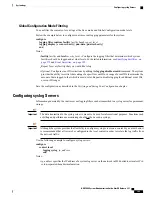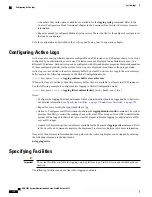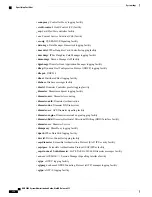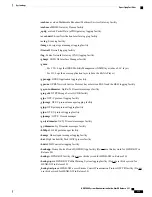
Description
Field
Displays the number of events currently logged in the active memory
buffer as well as a date/time timestamp for the oldest and most recent
entries in the buffer.
Active buffer
Displays the number of events currently logged in the inactive memory
buffer.
Inactive buffer
Viewing Event Logs Using the CLI
Event logs generated by the system can be viewed in one of the following ways:
•
From the syslog server:
If the system is configured to send logs to a syslog server, the logs can be
viewed directly on the syslog server.
•
From the system CLI:
Logs stored in the system memory buffers can be viewed directly from the CLI.
•
From the console port:
By default, the system automatically displays events over the console interface
to a terminal provided that there is no CLI session active.
This section provides instructions for viewing event logs using the CLI. These instructions assume that you
are at the root prompt for the Exec mode.
Step 1
Copy the active log memory buffer to the inactive log memory buffer.
When the active log memory buffer is copied to the inactive log memory buffer existing information in the inactive log
memory buffer is deleted.
Both active and inactive event log memory buffers can be viewed using the CLI in Exec mode. However, it is preferable
to view the inactive log in order to prevent any data from being over-written. The information from the active log buffer
can be copied to the inactive log buffer by entering the following command:
[local]
host_name
#
logs checkpoint
Step 2
View the logs by entering the following command:
[local]
host_name
#
show logs
A number of optional keywords/variables are available for the
show logs
command. Refer to the
Exec Mode Show
Commands
chapter in the
Command Line Interface Reference
for more information.
Configuring and Viewing Crash Logs
In the unlikely even of a software crash, the system stores information that could be useful in determining the
reason for the crash. This information can be maintained in system memory or it can be transferred and stored
on a network server.
The system supports the generation of the following two types of logs:
ASR 5000 System Administration Guide, StarOS Release 21.1
181
System Logs
Viewing Event Logs Using the CLI
Содержание ASR 5000
Страница 26: ...ASR 5000 System Administration Guide StarOS Release 21 1 xxvi Contents ...
Страница 44: ...ASR 5000 System Administration Guide StarOS Release 21 1 16 System Operation and Configuration Quoted Strings ...
Страница 114: ...ASR 5000 System Administration Guide StarOS Release 21 1 86 Config Mode Lock Mechanisms show administrators Command ...
Страница 184: ...ASR 5000 System Administration Guide StarOS Release 21 1 156 Monitoring the System Monitoring ASR 5000 Hardware Status ...
Страница 308: ...ASR 5000 System Administration Guide StarOS Release 21 1 280 Routing Viewing Routing Information ...
Страница 316: ...ASR 5000 System Administration Guide StarOS Release 21 1 288 VLANs VLAN Related CLI Commands ...
Страница 384: ...ASR 5000 System Administration Guide StarOS Release 21 1 356 Interchassis Session Recovery Fallback Procedure ...
Страница 400: ...ASR 5000 System Administration Guide StarOS Release 21 1 372 Engineering Rules ECMP Groups ...
Страница 426: ...ASR 5000 System Administration Guide StarOS Release 21 1 398 StarOS Tasks Management Processes ...
Страница 466: ...ASR 5000 System Administration Guide StarOS Release 21 1 438 ASR 5000 SDR CLI Strings ASR 5000 SDR CLI Command Strings ...






























